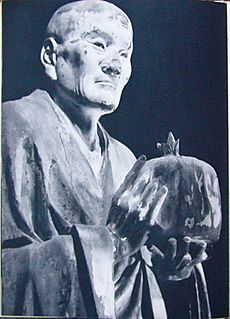Asanga facts for kids
Asaṅga (Tibetan: ཐོགས་མེད།, Wylie: thogs med, traditional Chinese: 無著; ; pinyin: Wúzhuó) was a very important Buddhist thinker and teacher from ancient India. He lived around the 4th century CE. He is known as one of the main founders of the Yogachara school of Mahayana Buddhism. This school focuses on how our minds create our experiences. Asaṅga taught at the famous Nalanda monastery in what is now Bihar, India. He and his half-brother, Vasubandhu, were key figures in explaining Mahayana Buddhist ideas, especially about awareness and the path to becoming a bodhisattva (someone who delays their own nirvana to help others).
Contents
Asaṅga's Life Story

Asaṅga was born in a place called Puruṣapura, which is now Peshawar in Pakistan. This area was part of the ancient kingdom of Gandhara. Scholars believe he lived in the 300s CE. He might have first belonged to a different Buddhist group, but he later became a follower of Mahayana Buddhism.
A Chinese monk named Xuanzang, who traveled to India, wrote about Asaṅga. He said that Asaṅga was first a monk from the Mahīśāsaka school. But he soon became very interested in Mahayana teachings. Asaṅga's half-brother, Vasubandhu, was also a monk. Vasubandhu later joined Mahayana Buddhism after meeting Asaṅga and one of his students.
Asaṅga spent many years meditating and studying with different teachers. However, an old story says he wasn't happy with his understanding. This story, told by a monk named Paramartha, says that Asaṅga used his special meditation powers. He traveled to a heavenly place called Tushita Heaven. There, he received teachings from Maitreya Bodhisattva about "emptiness" (a key Buddhist idea). He continued to visit Maitreya to learn more about important Mahayana scriptures.
Xuanzang, the Chinese monk, also shared a similar story:
In the great mango grove five or six li to the southwest of the city (Ayodhya), there is an old monastery where Asaṅga Bodhisattva received instructions and guided the common people. At night he went up to the place of Maitreya Bodhisattva in Tuṣita Heaven to learn the Yogācārabhūmi-śāstra, the Mahāyāna-sūtra-alaṃkāra-śāstra, the Madhyānta-vibhāga-śāstra, etc.; in the daytime, he lectured on the marvelous principles to a great audience.
Today, scholars discuss whether Maitreya in this story was a real human teacher or a vision Asaṅga had during meditation. Either way, Asaṅga's experiences led him to travel all over India. He shared the Mahayana teachings with many people. One historical account says he started 25 Mahayana monasteries in India.
Asaṅga's Writings
Asaṅga wrote several important books, called treatises or shastras, for the Yogācāra school. Over time, many different works were said to be by him. Sometimes, they were even said to be from Maitreya, with Asaṅga just sharing them. However, there are differences between the Chinese and Tibetan lists of his works. Modern scholars have also studied these texts carefully and questioned who wrote some of them.
The many works linked to Asaṅga can be put into three main groups:
Works Definitely by Asaṅga
These three works are widely agreed by both old and new scholars to be written by Asaṅga:
- Mahāyānasaṃgraha (Summary of the Great Vehicle): This book explains the main ideas of the Yogacara school in ten chapters. It is seen as his most important work. Copies exist in Tibetan and Chinese.
- Abhidharma-samuccaya: This is a short summary of important Mahayana Buddhist ideas. It is written in a traditional Buddhist style. The original Sanskrit version still exists.
- Xianyang shengjiao lun: This work is closely based on another text called the Yogācārabhūmi. Only a Chinese translation by Xuanzang exists, but parts of it can be found in the Yogācārabhūmi.
Works Attributed to Maitreya (through Asaṅga)
The next group of texts are those that Tibetan stories say Maitreya taught to Asaṅga. In Tibetan Buddhism, these are known as the "Five Dharmas of Maitreya." These works are:
- Mahāyānasūtrālamkārakārikā ("The Adornment of Mahayana sutras"): This book explains the Mahayana path from the Yogācāra point of view.
- Dharmadharmatāvibhāga ("Distinguishing Phenomena and Pure Being"): A short Yogācāra work that talks about the difference between everyday things (phenomena) and true reality.
- Madhyāntavibhāgakārikā ("Distinguishing the Middle and the Extremes"): This book has 112 verses and is a very important text in Yogācāra philosophy.
- Abhisamayalankara ("Ornament for clear realization"): This text tries to combine the ideas of Prajnaparamita (Perfection of Wisdom) and Yogacara thought. Some scholars think a different person might have written it.
- Ratnagotravibhaga (Exposition of the Jeweled lineage): This book is about Buddha-nature (the idea that everyone has the potential to become a Buddha). The Tibetan tradition says Maitreya gave it to Asaṅga. However, the Chinese tradition says a different person named Sāramati wrote it. Many modern scholars agree with the Chinese view.
The Chinese tradition also talks about five Maitreya texts, but their list is a bit different. One very large book, the Yogācārabhūmi śāstra, is a huge collection of teachings on spiritual practice. While it was traditionally linked to Asaṅga or Maitreya, most modern scholars believe it was put together by many different authors. However, Asaṅga might have helped in compiling parts of it.
Other Attributed Works
A third group of texts sometimes linked to Asaṅga are two commentaries (explanations of other texts). These are the Kārikāsaptati (on the Diamond Sutra) and the Āryasaṃdhinirmocana-bhāṣya (a commentary on the Sandhinirmocana Sutra). However, many modern scholars do not widely accept that Asaṅga wrote these two works.
See also
 In Spanish: Asanga para niños
In Spanish: Asanga para niños


